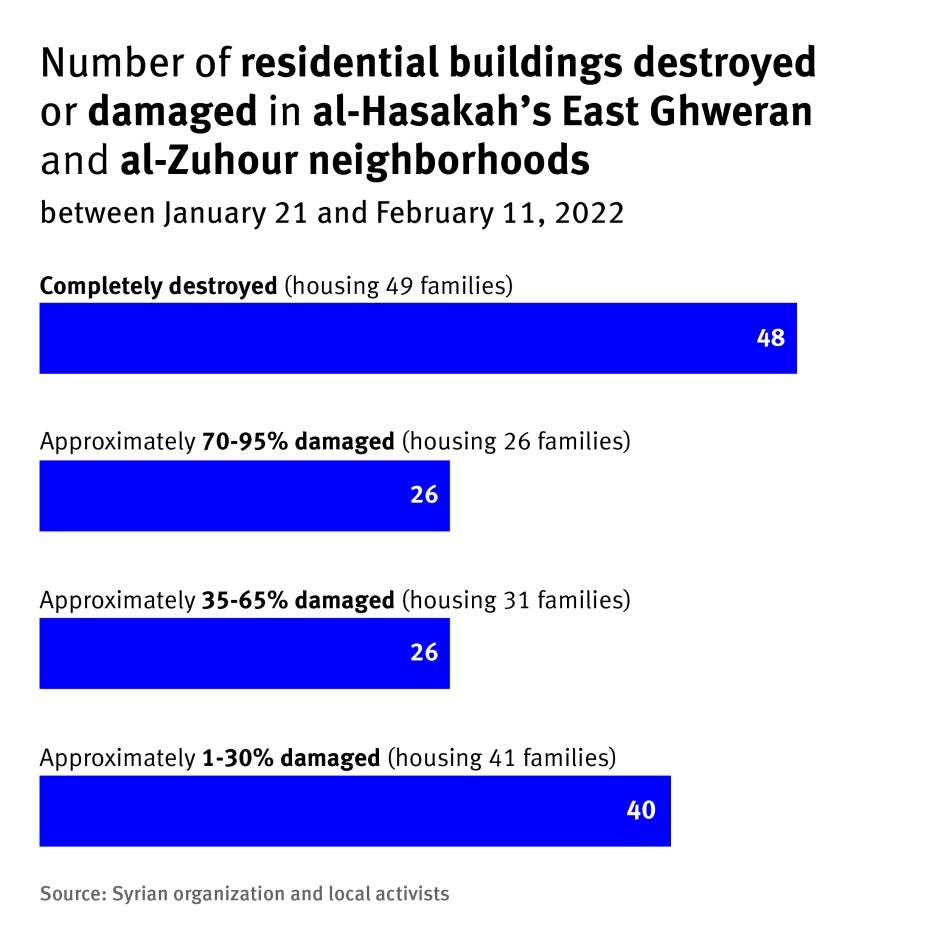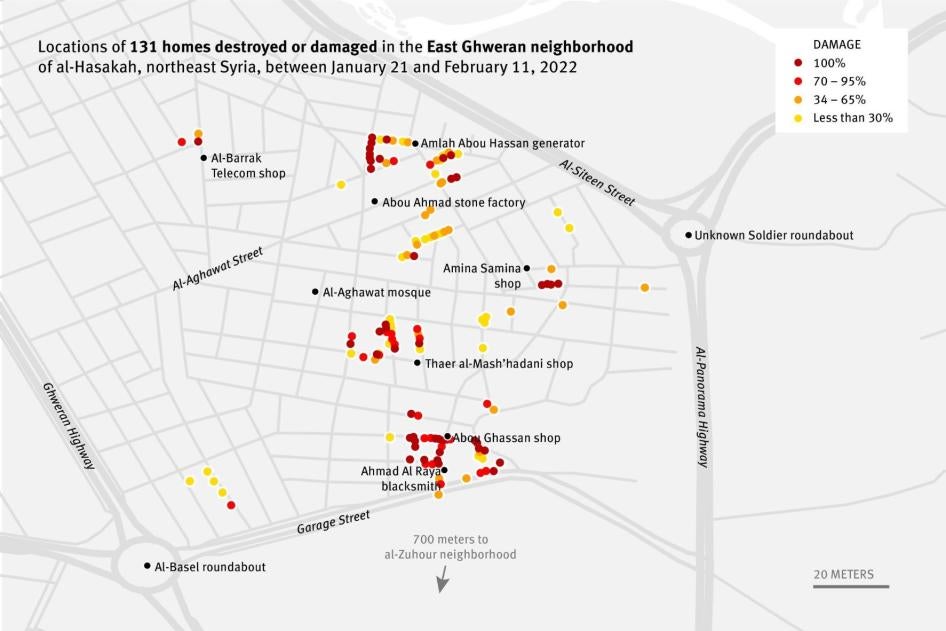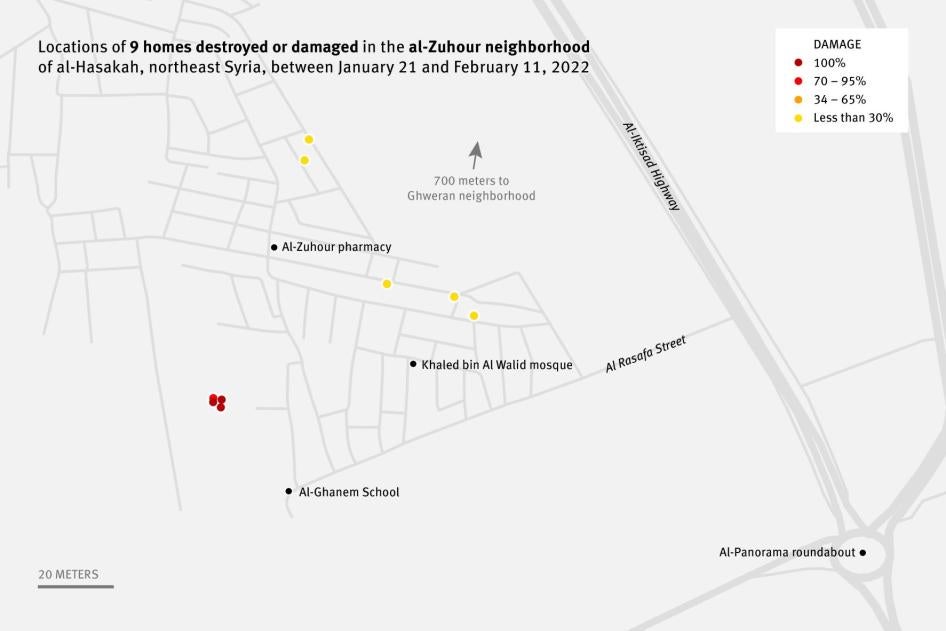The Syrian Democratic Forces (SDF) in northeast Syria destroyed or damaged at least 140 private buildings housing 147 families in January and February 2022 while trying to capture fleeing detainees and Islamic State (ISIS) fighters who attacked a nearby prison, Human Rights Watch said today. Witnesses said the SDF used bulldozers to demolish houses in al-Hasakah city's East Ghweran and al-Zuhour neighborhoods.
Witnesses and a United Nations investigative committee said that ISIS fighters had entered homes during the military operation, and the SDF told Human Rights Watch that it detonated ISIS-placed explosives during its search operations. The SDF should compensate people whose homes it unlawfully damaged or destroyed and make financial or other amends to all others affected by the destruction. It should explain why it concluded it had no choice but to destroy peoples' homes in order to secure them. Members of the United States-led coalition against ISIS that helped the SDF secure the prison should encourage the SDF to make amends and help it to do so.
"The Syrian Democratic Forces have yet to fully and publicly explain why they needed to destroy dozens of homes to capture the prison attackers and secure the area," said Gerry Simpson, associate crisis and conflict director at Human Rights Watch. "In the meantime, they should help affected families rebuild their lives."
On January 20, ISIS fighters attacked al-Sina'a prison in the Ghweran neighborhood of al-Hasakah, sparking a 10-day battle with the SDF, which was supported by US and UK ground and air forces as part of the US-led Global Coalition to Defeat ISIS. The US provides the SDF with hundreds of millions of dollars in technical and financial support.
The prison held about 4,000 male ISIS suspects or family members, including 700 boys, from Syria and about 2 dozen other countries. The SDF said on January 31 that it had regained full control of the prison and surrounding neighborhoods, and that the fighting had left more than 500 people dead. The UN said that the fighting initially displaced at least 45,000 residents.
Between January 21 and at least February 11, the SDF and local security forces known as Asayish deployed in various parts of the city to find escaped detainees and ISIS fighters who had attacked the prison, including in the Ghweran, al-Mufti, al-Nasirah, and al-Zuhour neighborhoods. The UN Commission of Inquiry on Syria said that some ISIS fighters "sought shelter in residential areas," prompting the operation, termed the "People's Hammer," and by January 23, 6,000 residents in Ghweran and al-Zuhour had fled their homes.
Between February 2 and June 20, Human Rights Watch interviewed 18 people from the Ghweran neighborhood by telephone who said that the operations had destroyed their homes. While some of the damage may have resulted from armed clashes between SDF forces and ISIS suspects, three residents said they saw or heard heavy vehicles they described as bulldozers destroying their or other people's homes. Eleven others said that when they returned to their neighborhoods and found their home destroyed, neighbors told them the SDF had bulldozed their and other people's property. The UN says that its analysis of satellite imagery relating to 40 affected buildings in neighborhoods near the prison revealed that some had been destroyed by "military grade bulldozers."
A survey by local activists carried out in the city and nearby villages concluded that the operation resulted in the destruction of, or damage to, 140 buildings between January 21 and February 11.
A woman from an area in the East Ghweran neighborhood fled the area on January 21 with her extended family who lived with her. She returned on February 2 and later described what she saw: "Our house, and about 10 nearby, had been razed to the ground. Nothing was left unharmed … The rubble is still there [in mid-March], and we are homeless."
She said neighbors told her that ISIS fighters were in her house and when they refused to leave, the SDF brought bulldozers and destroyed the house and others nearby.
Human Rights Watch sent an overview of its findings and related questions on June 28 to the SDF. In a reply dated July 21, the group's General Commander Mazloum Abdi said that ISIS members used residents' homes "as hideouts and weapons depots," took civilians hostage, killed civilians, refused to surrender, and then placed landmines and explosive devices in the homes, which the SDF had detonated "during search [operations] out of security and military necessity."
Abdi also said the group had only used light and medium weapons during the operation and acted with "precision and caution to protect civilians' lives and property." The commander concluded by saying that the international community, "in particular countries whose nationals are detained in northern and eastern Syria, bears the greatest responsibility for any [events] such as the attack on al-Sina'a prison."
Human Rights Watch was unable to corroborate whether ISIS fighters placed explosive devices in houses and has not been able to identify any criminal investigations or prosecutions in connection with the property destruction. The SDF have not informed affected residents of any compensation, reconstruction, or alternative housing plans.
On October 7, Human Rights Watch also wrote to the US Departments of State and Defense with a summary of its findings and asking for details on the coalition's involvement in military operations that resulted in the destruction and damage of homes in al-Hasakah. Human Rights Watch has not received a reply.
All parties to Syria's internal armed conflict are required to respect international humanitarian law, which prohibits attacks directed at civilian objects, such as civilian homes. If a civilian object such as a building is used for military purposes, and becomes a military objective, attacks directed at it cannot be indiscriminate or disproportionate; that is, the anticipated civilian deaths, injuries, and other harm including damage to civilian objects should not be excessive in relation to the concrete and direct military advantage anticipated. Destruction or seizure of property except for reasons of imperative military necessity is not permitted.
The SDF and the Autonomous Administration of Northeast Syria (AANES) also have a responsibility to respect human rights law, including the right to adequate housing, which includes protection against the arbitrary destruction and demolition of one's home, and the obligation to provide adequate compensation and shelter to those affected if and when this occurs. The SDF should conduct an investigation to determine whether the destruction of homes was consistent with humanitarian law and human rights standards, and compensate anyone whose home was unlawfully damaged or demolished, Human Rights Watch said.
The US government is authorized and resourced under section 1213 of the fiscal year 2020 National Defense Authorization Act to make "ex-gratia" (as a favor or out of kindness) payments to civilians harmed by US military or partnered operations globally. Ex-gratia payments may be made from one individual, organization, or government to another without admitting liability. The US government is also authorized under its security assistance to the SDF to help it make such payments.
"The SDF should make amends to the victims of operation 'People's Hammer,' and members of the US-led coalition against ISIS should offer support," Simpson said. "In the meantime, affected families need immediate help, especially with winter coming."
Since the conflict in Syria began in 2011, Human Rights Watch and other rights groups have documented unlawful home demolitions, as well as property destruction and seizure of civilian property, including by security forces linked to the AANES, without owners being compensated. For more than three years, the AANES has also unlawfully detained tens of thousands of foreign ISIS suspects and family members in prisons and camps who were captured when the SDF and US-led coalition routed ISIS from its last stand in Syria in 2019. The AANES and the US-led coalition have repeatedly urged governments to repatriate their nationals, but a majority have refused to take all or any back.
Methodology
Between February 2 and June 20, Human Rights Watch interviewed 18 people by telephone about the complete or partial demolition of their homes during SDF operations in al-Hasakah between January 21 and February 2. Human Rights Watch reviewed photographs and videos showing the destroyed homes of three of the people interviewed, including two of the three witnesses who were present when their homes were destroyed. These include a photograph posted on social media in January, photographs taken by Agence France-Presse on January 29, and videos and photographs taken between January and April that witnesses shared directly.
Human Rights Watch also reviewed other videos and photographs posted on social media in January and February showing destroyed buildings in the East Ghweran neighborhood, including television interviews with residents of destroyed buildings, photographs and videos of destroyed or damaged buildings, and other information provided by local activists who carried out the survey of the damage and destruction.
Additionally, Human Rights Watch analyzed satellite imagery of al-Sina'a prison and surrounding neighborhoods recorded before and after January 20, showing damage to about 110 buildings in the East Ghweran and Zuhour neighborhoods that occurred mostly between January 25, 2022, and February 6, 2022. The satellite imagery did not reveal the cause of the damage.
To protect witnesses' identities, Human Rights Watch did not publish any photographs relating to specific properties.
The local activists who carried out the survey said they had interviewed representatives of 84 of the 147 families who lost their homes in the East Ghweran and Zuhour neighborhoods. The survey determined that 48 multi-story buildings housing 49 families had been completely destroyed, 26 buildings housing 26 families were severely damaged, 26 buildings housing 31 families were moderately damaged, and 40 buildings housing 41 families were partially damaged. The survey found that 131 of the buildings were in East Ghweran and 9 were in al-Zuhour.
The Human Rights Watch analysis of satellite imagery indicates damage to at least 100 buildings in the East Ghweran neighborhood and to about 10 buildings in al-Zuhour neighborhood that occurred after January 20. Satellite imagery recorded on January 28 confirms that most of the damage had been done in both neighborhoods by that time. Satellite imagery collected on February 6 shows that some additional pockets of destruction took place after January 28.
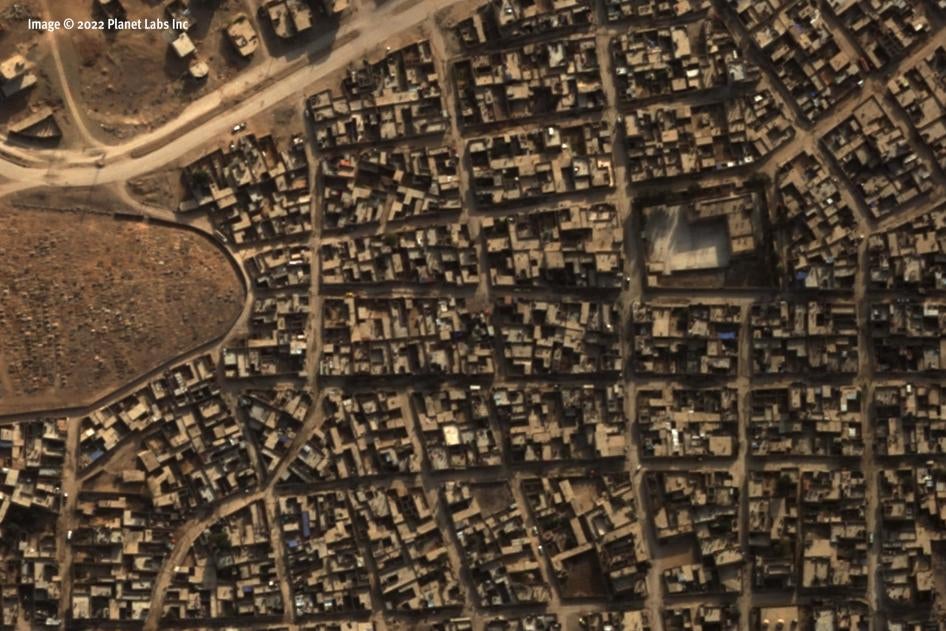
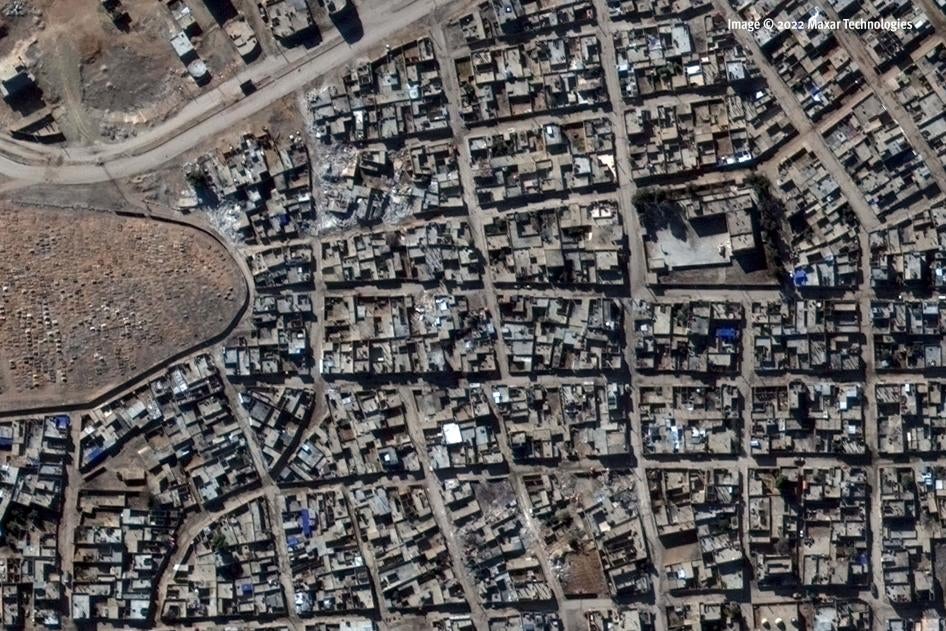
Before: East Ghweran, December 14, 2021.: © 2022 Planet Labs Inc. After: East Ghweran, January 28, 2022.: © 2022 Maxar Technologies
Satellite imagery of East Ghweran neighborhood in al-Hasakah city, Northeast Syria, showing intact buildings on December 14, 2021, and showing damaged buildings on January 28, 2022.
Human Rights Watch compared the satellite imagery with the 31 general areas of destruction identified by the local activists in their survey. The imagery captured destroyed and severely damaged buildings in some of those areas, including those most seriously affected, but was unable to capture minor damage to buildings, including to facades, that the survey identified.
Public Statements by SDF and AANES of Northeast Syria
In a January 31 statement, the SDF General Command said that it had "conducted a sweep and clear-up operation against Daesh [ISIS] terrorists in the vicinity of the prison" which resulted in the "recapture … of all the terrorist detainees." However, the same day, an SDF commander from the group, Haqqi Kobani, said that the forces were "still searching in all neighborhoods of al-Hasakah for ISIS cells, and those who may be escaping from al-Sina'a Prison and hiding in civilian homes."
On April 20, an official from the AANES, the administrative body for northeast Syria, said publicly that one of its committees had looked into the destruction and concluded that 62 buildings had been completely destroyed and 58 had been partially damaged in the Ghweran and Zuhour neighborhoods, without specifying what had caused the damage. The official said that the committee had submitted its report to the AANES's Jazira Regional Executive Council, one of its most important decision-making bodies in al-Hasakah Governorate. According to another media report, the Autonomous Administration said it would share its conclusions on the destruction with the SDF.
Homes Demolished in al-Hasakah, January 21 to February 11
Among the 18 people interviewed, one said the SDF used a bulldozer to destroy a part of his house while he was inside it. Another said they saw the forces using a bulldozer to destroy other people's houses, while a third said she saw these forces next to a bulldozer shooting at ISIS suspects in a nearby building and then heard what she believed was a bulldozer destroying houses.
Eleven people who left the area on January 21 to flee the fighting in their neighborhood said that when they returned and found their homes destroyed, neighbors told them the SDF had bulldozed their and other people's property. The other four did not know or hear from others about how their houses had been destroyed. All 18 said that the authorities had not contacted them to say whether they would be compensated for the loss of, or damage to, their homes.
A man described how what he said were SDF forces demolished part of his home in the East Ghweran neighborhood with a bulldozer while he was still inside at about 5 p.m. on January 22:
I was alone in my house. I heard shooting and an explosion nearby. Then everything happened very quickly. They brought down the wall of a room with a bulldozer. The room began to shake, and the wall collapsed. I went outside and saw about 50 SDF soldiers with 3 or 4 armored vehicles and a large yellow bulldozer. They told me to raise my hands and said ISIS was in my home. I told them I was the owner and that they could go inside and check. They went in, checked everything, and saw no one was there.
The next day the SDF told me and my neighbors to leave the area and I did. Soon after that I got the news my house had been destroyed. I went back about a week later. My house had been destroyed, together with about nine other houses.
The local activists provided the exact location of the demolished building, as well as two videos and two photographs they said they had taken on April 4 showing the rubble of the man's home. A photograph posted to Facebook on January 26 also shows the destroyed house. The man said he did not know how his house had been destroyed, beyond the initial partial demolition by bulldozer that he witnessed.
Human Rights Watch independently verified the location of, and damage to, the home by matching the streets and buildings, and extent of the destruction visible in the photographs and videos with January 28 satellite imagery. The satellite imagery also shows at least seven other completely destroyed buildings in the immediate vicinity. Low resolution satellite imagery of the same location taken in the early morning on January 21 shows that the houses were intact, while satellite imagery taken on January 25 shows the destroyed houses.
Human Rights Watch also obtained a video of a large construction vehicle moving debris in a residential area, with a khaki-colored military vehicle parked nearby that is an Oshkosh M-ATV, a type of armored military vehicle used by the coalition forces and the SDF in northeast Syria.
The same man said the video was filmed on February 2 by one of his neighbors. Human Rights Watch matched the shape of the buildings and streets visible in the video with satellite imagery to locate the vehicle moving debris, which is about 30 meters north of the man's destroyed home.
Human Rights Watch spoke by telephone with two other people in Syria who said they saw the SDF using bulldozers to demolish other people's houses.
Another man who had lived in the East Ghweran neighborhood with his family described what neighbors told him had happened to his house after he fled the area and what he saw the forces do to other nearby houses after he had returned:
The day after the prison incident, the SDF ordered my family to evacuate our home, and we went to a different, safer area. Most people who evacuated our area didn't come back until 10 or 15 days later, but I was worried our house would get looted, so I went back a week later [about January 28]. The entire area was sealed off, but the SDF let me into my area. When I reached our house, I saw it had been completely destroyed. I also saw three of my neighbors' houses had been destroyed and there were five other houses nearby that were half or three quarters destroyed. It was devastating and I had a nervous breakdown.
There were bulldozer tire marks on the ground next to my destroyed house. My neighbors told me that they saw the SDF use a bulldozer to destroy my house. They said that while I was away, people would tell the SDF when ISIS members had entered a house and then the SDF came to negotiate their surrender. If they didn't surrender, the SDF would open fire on them in the house and then used a bulldozer to destroy it.
When I returned, I stayed in my son's house, which was not damaged. I heard that ISIS members were still in two neighborhoods next to ours. On the second day after I had returned, clashes erupted near the al-Aghawat mosque at about 10 a.m. and I went to see what was happening. The SDF sealed off the road but a lot of us watched as the SDF brought a bulldozer and destroyed a two-story house with a pharmacy on the ground floor and a house next door.
The next day, there were more clashes at about 1 p.m. nearby. I went to see what was happening. There were lots of SDF soldiers and they sealed off the roads. They fired at houses for an hour or so and then they brought a big yellow Caterpillar bulldozer and destroyed 2 or 3 houses.
The local activists who carried out the survey provided the exact location of the man's building, in the southern part of the East Ghweran neighborhood. Human Rights Watch observed on the January 28 satellite imagery that the building and at least two others next to it had been damaged.
A woman who lives in the East Ghweran neighborhood said she saw SDF forces on January 29 next to what she said was a bulldozer and that she then heard what she believed was the sound of a bulldozer demolishing buildings:
It was 8:30 a.m., and I was at home when my neighbors told me that four strangers had entered one of the houses on our block and that they had called the SDF to tell them. Many [houses] were empty because families had left the neighborhood due to the fighting between the SDF and ISIS suspects.
At 9 a.m. I started to hear short bursts of shooting and that continued for five hours. At 2 p.m. the shooting got more intense, and I left my house to see what was happening. I walked for about five minutes to reach the area where the sounds were coming from, on the corner of our block. I saw one red bulldozer and four military vehicles. Two [of the military vehicles] belonged to the SDF and two were from the [international anti-ISIS] coalition. There were no soldiers in them or flags on them, but I know they were from the coalition because their vehicles are larger than the SDF's vehicles. There were also about 15 SDF soldiers wearing their usual black uniform.
The bulldozer wasn't moving. It was parked in the street and none of the buildings in the street nearby were damaged. The SDF used loudspeakers to tell the ISIS guys in one of the buildings to surrender, but they did not reply.
When the soldiers saw me, they told me to go home, so I moved 50 meters away and watched from there for about an hour. The soldiers shot at the house where they thought ISIS was hiding. No one shot back at them. Then I went home. Just after I reached home, I heard a very loud sound that lasted for about 30 seconds. I thought it sounded like the bulldozer was destroying a house. We know that sound because when people want to rebuild their house, they use a bulldozer to destroy the old one.
I stayed in my house and didn't go out again that day. I left the house the next day and I went to the same area. When I got there, I saw two houses completely destroyed, including a phone shop and a pharmacy. They also partially destroyed two other houses next door, maybe about 60 percent of each one.
The woman provided photographs of three damaged buildings she said she had taken on January 30, which matched the photographs' metadata. The local activists provided the location of the damaged buildings, in the northern part of the East Ghweran neighborhood.
Human Rights Watch independently verified the location of the three damaged buildings, near the Fatima Al-Zahra Mosque, matching the shape of the buildings and landmarks in the photographs with satellite imagery. Imagery recorded on January 28 shows no signs of damage, but a February 1 image shows a cluster of heavily damaged buildings.
Human Rights Watch analyzed four photographs taken by Agence France-Presse on January 29, including two depicting soldiers, which show a number of vehicles parked close by the same three houses.
By matching the buildings and electricity poles in both sets of photographs, Human Rights Watch concluded they were taken in the same location.
The Agence France-Presse photographs show four vehicles, including a red loader, used to move materials such as soil or debris onto another type of machinery to dispose of the material; a black military vehicle; and at least two khaki-colored military vehicles. According to the photographer, forces wearing khaki uniforms are US soldiers and forces wearing black and darker military uniforms are members of the SDF. The khaki-colored vehicles are also Oshkosh M-ATVs. The Agence France-Presse photographs taken at 2 p.m. on January 29 show the houses still intact.
One man who fled his home and heard from neighbors what happened said he had lived with his brother north of al-Sina'a prison in the East Ghweran neighborhood. Their home is close to the home of the man who told Human Rights Watch he was inside it when the SDF damaged it with a bulldozer. He said:
On Friday [January 21] the SDF said we had to leave the area, so I took my family to stay with relatives. Two days later, I heard from someone who was still in my neighborhood that the SDF had destroyed a part of my house because they suspected that there were two ISIS members inside it. The next day, a neighbor called and said the SDF had used a bulldozer to destroy 13 houses in our block, including my entire house. The SDF allowed us to go back on January 31. I went back that day and found my home destroyed, and I saw lots of other destroyed homes in my area.
The man provided four photographs of his destroyed home and of destroyed properties next to it, which he said he had taken on February 3. They show large and deep tire marks on the ground consistent with the presence of a heavy vehicle.
The local activists also provided the building's location. Human Rights Watch identified on the January 28 satellite imagery that a building at that location was destroyed. The photographs and satellite imagery show several landmarks that match, including the layout and shape of buildings and the position of two trees. The direction and height of the sun seen setting over one building matches the time of day the photographs were taken, according to the photograph's metadata.
However, due to the resolution of the satellite imagery and the partially and completely destroyed state of the buildings in the area, Human Rights Watch was unable to independently verify with certainty that the location of the buildings in the photographs matched the specific location provided by the local activists.
Legal Obligations
Under international humanitarian law, parties to an internal armed conflict, such as the one in Syria, may only direct attacks against military objectives, objects that "by their nature, location, purpose or use make an effective contribution to military action and whose total or partial destruction, capture or neutralization, in the circumstances ruling at the time, offers a definite military advantage."
The intentional or wanton destruction of civilian objects, which include private homes, is unlawful. Destroying civilian objects merely to punish the population is always prohibited. A civilian object becomes subject to attack as a military objective when it makes an effective contribution to military action. Examples include situations in which opposing forces are deployed in a civilian property or opposing forces are expected to imminently deploy in a civilian property to stage an attack. In case of doubt, there is a presumption that objects normally dedicated to civilian purposes, such as houses, schools, and places of worship, are not subject to attack.
Any attack, even if on a military object, must not be indiscriminate or disproportionate. A disproportionate attack is one in which the expected incidental loss of civilian life and damage to civilian objects would be excessive in relation to the concrete and direct military advantage anticipated. Destruction or seizure of property except for reasons of imperative military necessity is not permitted. The intentional and wanton destruction of civilian property may constitute war crimes and those responsible should be held to account.
The right to adequate housing under human rights law, which is part of the right to an adequate standard of living, includes protection against forced evictions and the arbitrary destruction and demolition of one's home. Individuals concerned have a right to adequate compensation for any property affected, as part of an effective remedy for the violation of their rights. Those who are left homeless as result of displacement or destruction of their homes have a right to shelter.
Recommendations
The Syrian Democratic Forces should take all necessary steps to end destruction of and damage to civilian homes and other property by its forces in the absence of imperative military necessity. They should open a transparent investigation into the destruction of, and damage to, homes in al-Hasakah during the January and February military operations, compensate fairly those whose homes were unlawfully damaged, and make ex-gratia payments or provide housing to all those affected. The AANES should also investigate the destruction and make recommendations to the SDF on how to respond, in line with international law.
The Global Coalition to Defeat ISIS, including the US and United Kingdom, which have deployed in northeast Syria in support of the SDF, should encourage the SDF to fairly compensate or provide amends, including housing, to victims of the destruction of, and damage to, homes in al-Hasakah during the January and February operations. They should consider providing financial support to the SDF to help make ex-gratia payments. They should also press the SDF to open a transparent and impartial investigation into the destruction.

